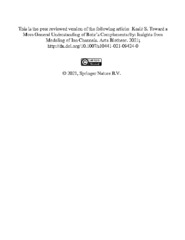Приказ основних података о документу
Toward a More General Understanding of Bohr's Complementarity: Insights from Modeling of Ion Channels.
| dc.creator | Kesić, Srđan | |
| dc.date.accessioned | 2021-10-15T10:13:06Z | |
| dc.date.accessioned | 2021-10-15T10:57:27Z | |
| dc.date.available | 2022-09-28 | |
| dc.date.issued | 2021 | |
| dc.identifier.issn | 0001-5342 | |
| dc.identifier.uri | https://link.springer.com/10.1007/s10441-021-09424-0 | |
| dc.identifier.uri | https://radar.ibiss.bg.ac.rs/handle/123456789/4494 | |
| dc.identifier.uri | https://radar.ibiss.bg.ac.rs/handle/123456789/4496 | |
| dc.description.abstract | Some contemporary theorists such as Mazzocchi, Theise and Kafatos are convinced that the reformed complementarity may redefine how we might exploit the complexity theory in 21st-century life sciences research. However, the motives behind the profound re-invention of "biological complementarity" need to be substantiated with concrete shreds of evidence about this principle's applicability in real-life science experimentation, which we found missing in the literature. This paper discusses such pieces of evidence by confronting Bohr's complementarity and ion channel modeling practice. We examine whether and to what extent this principle might assist in developing ion channel models incorporating both deterministic and stochastic solutions. According to the "mutual exclusiveness of experimental setups" version of Bohr's complementarity, this principle is needed when two mutually exclusive perspectives or approaches are right, necessary in a particular context, and are not contradictory as they arise in mutually exclusive conditions (mutually exclusive experimental or modeling setups). A detailed examination of the modeling practice reveals that both solutions are often used simultaneously in a single ion channel model, suggesting that the opposite conceptual frameworks can coexist in the same modeling setup. We concluded that Bohr's complementarity might find applications in these complex modeling setups but only through its realistic phenomenological interpretation that allows applying different modes of description regardless of the nature of the underlying ion channel opening process. Also, we propose the combined use of complementarity and Complex thinking in building the multifaceted ion channel models. Overall, this paper's results support the efforts to establish a more general form of complementarity to meet today's complexity theory-inspired life sciences modeling demands. | |
| dc.publisher | Dordrecht: Springer Science and Business Media B.V. | |
| dc.relation | info:eu-repo/grantAgreement/MESTD/inst-2020/200007/RS// | |
| dc.relation.isversionof | https://radar.ibiss.bg.ac.rs/handle/123456789/4494 | |
| dc.rights | embargoedAccess | |
| dc.source | Acta Biotheoretica | |
| dc.subject | Complementarity | |
| dc.subject | Complex thinking | |
| dc.subject | Deterministic model | |
| dc.subject | Ion channels | |
| dc.subject | Realist phenomenology | |
| dc.subject | Stochastic model | |
| dc.title | Toward a More General Understanding of Bohr's Complementarity: Insights from Modeling of Ion Channels. | |
| dc.type | article | en |
| dc.rights.license | ARR | |
| dcterms.abstract | Кесић, Срђан; | |
| dc.rights.holder | © 2021, Springer Nature B.V. | |
| dc.citation.volume | 69 | |
| dc.description.note | This is the peer reviewed version of the following article: Kesić S. Toward a More General Understanding of Bohr’s Complementarity: Insights from Modeling of Ion Channels. Acta Biotheor. 2021; [http://dx.doi.org/10.1007/s10441-021-09424-0] | |
| dc.identifier.doi | 10.1007/s10441-021-09424-0 | |
| dc.identifier.pmid | 34585309 | |
| dc.identifier.scopus | 2-s2.0-85115838535 | |
| dc.identifier.wos | 000701596500001 | |
| dc.citation.apa | Kesić, S. (2021). Toward a More General Understanding of Bohr’s Complementarity: Insights from Modeling of Ion Channels. Acta Biotheoretica. (69) 723-744. | |
| dc.citation.vancouver | Kesić S. Toward a More General Understanding of Bohr’s Complementarity: Insights from Modeling of Ion Channels. Acta Biotheor. 2021;69:723-44. | |
| dc.citation.spage | 723 | |
| dc.citation.epage | 744 | |
| dc.type.version | acceptedVersion | |
| dc.identifier.fulltext | https://radar.ibiss.bg.ac.rs/bitstream/id/9348/bitstream_9348.pdf | |
| dc.citation.rank | M23 |

